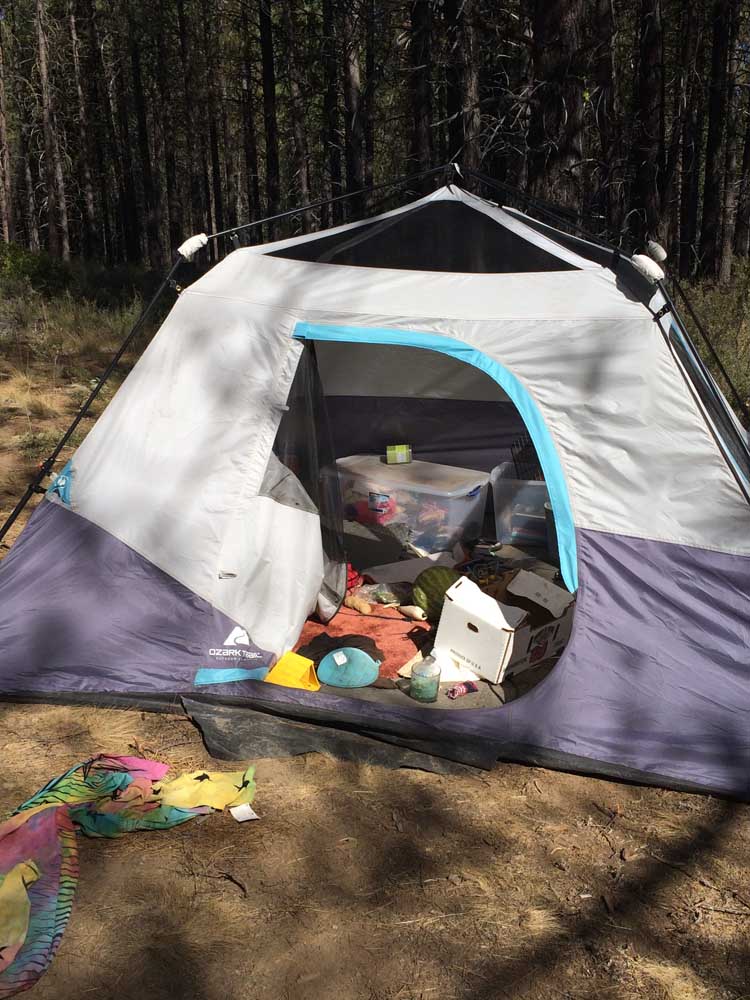Increased use brings trash, fire risk to Phil’s Trailhead
Published 12:00 am Tuesday, August 28, 2018

- An abandoned campsite sits near the burn scar from a small fire near Forest Road 4610. (Submitted Photo)
About 100 yards from the road leading to Phil’s Trailhead, a large pile of 2-year-old trash, ranging from old books to discarded corn husks, lies in a grass field.
Bend resident Hugh Sawyer noticed the debris while walking his dog, Shadow, in the area and said he suspected it came from dispersed campers who didn’t clean up after themselves.
“Their parents didn’t teach them to pick up their trash?” Sawyer said.
The trash pile near one of Central Oregon’s most famous mountain biking areas, while not exactly common, is not unique in the area either. Sawyer said he’s seen a handful of trash piles, abandoned tents and other signs of neglect from people camping near Phil’s Trail and other trail systems near Skyliners Road, west of Bend.
While Sawyer noted that the vast majority of campers pick up after themselves and obey the rules, he said the ones who don’t can harm the forest, leave debris that attracts wildlife and even start fires that can spread quickly through the dry forest.
“One bad apple spoils the whole bunch,” he said.
Kassidy Kern, acting public affairs officer with the Deschutes National Forest, said the U.S. Forest Service hasn’t had an unusual number of problems with dispersed campers in the area along Skyliners Road, but said more people are camping in the Central Oregon forest than ever, particularly near populated areas.
“I would say we’re seeing an uptick in dispersed camping in the areas of the forest near Bend and Sisters,” Kern said.
Dispersed camping — camping in the national forest in areas outside of dedicated campsites — is perfectly legal in much of the Deschutes National Forest, provided campers follow the rules. Campers are expected to carry out what they carry in, and they aren’t permitted to stay in the same spot in the national forest for more than two weeks, Kern said.
While Kern said the Forest Service focuses on education first, warnings and tickets can follow if campers don’t comply.
She added that the uptick in dispersed camping fits into a larger pattern over increasing use in Central Oregon’s national forests. While dispersed camping totals can be hard to pinpoint, Kern said the number of visitors in wilderness areas — portions of the forest governed by the federal Wilderness Act of 1964 — more than doubled between 2014 and 2016.
“We’re just seeing more people in general,” she said.
Sawyer added that he’s seen a significant increase in the number of RVs near Forest Road 4610, down Skyliners from the turn-off for Phil’s Trailhead, in his time visiting the area.
Dispersed campers tend to prefer to be near recreational areas, but also close to cities and towns where they can gather food and other supplies, according to Kern.
Bruce Schroeder, board member for Central Oregon Trail Alliance, said the area near Forest Road 4610 acts as a jumping-off point for a number of biking and hiking trails west of Bend. Consequently, the area attracts a variety of campers, from homeless people to Bend residents looking for a weekend in the woods.
Schroeder said he uses trails in the area, and hasn’t spotted a disproportionate amount of trash left there. Still, he noted that the area is getting more crowded, and more trash may be an offshoot of that.
“I’m not sure what it looks like to a tourist’s eyes,” Schroeder said. “It can’t be good.”
Sawyer, who often walks his dog and rides electric bikes in the area, acknowledged that the problems aren’t new, and added that he’s been concerned about the impact of the trash on the forest and the animals living there for a while. What pushed him over the edge, though, was seeing the scar from a small fire near Forest Road 4610, right next to a wide-open, abandoned tent site.
Sawyer suspects the campers in the area may have started the fire. While this particular fire didn’t grow, Sawyer said it easily could have, and others may turn into wildfires in the future.
“As you can see, there’s the potential for some bad stuff,” he said.
Kern said the Forest Service didn’t have a record of fire starting near 4610, and noted that the people who started the fire may also have been responsible for putting it out.
Still, she said unattended campfires are a challenge throughout the forest during the summer, when dry conditions can allow a fire to quickly erupt into a wildfire.
“All of us just sort of roll our eyes, because it’s such a tragic and preventable thing,” Kern said.
Deschutes National Forest, along with the Ochoco National Forest, the Crooked River National Grassland and the Prineville district of the Bureau of Land Management, prohibited campfires outside of specific designated campsite fire rings on July 24, part of a series of restrictions designed to mitigate wildfires. Kern said the Forest Service could prohibit campfires outright if they encounter enough problems with escaped fires, though that hasn’t been the case so far.
Still, she said human-caused fire is a concern, especially with so many fires burning across the West, which pulls resources away from Central Oregon.
“We’re a little bit lean on law enforcement,” she said.
Sawyer suggested a tip line, where visitors can report trash and other violations in a central location.
He also said the Forest Service could look at adding campsites in the area, though Kern noted that many visitors, herself included, prefer dispersed camping to dedicated campsites as a more authentic way to appreciate the wilderness.
“It’s really experiential,” she said.
— Reporter: 541-617-7818, shamway@bendbulletin.com






